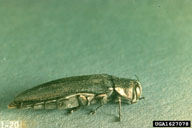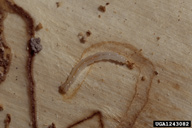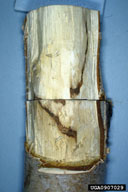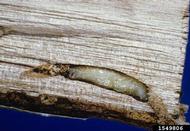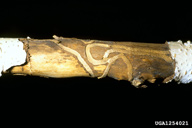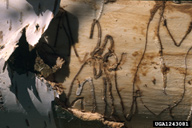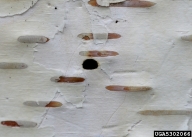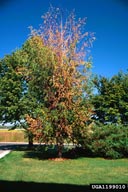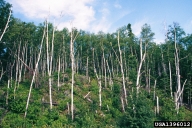Bronze birch borer
Agrilus anxius Gory (Coleoptera: Buprestidae)
Orientation to pest
Bronze birch borer, Agrilus anxius Gory, adults are slender, olive-bronze beetles, with a coppery reflection. The species is native to North America and is widespread in the eastern and central United States and southeastern Canada. Before 1950, bronze birch borer and another species, now called aspen borer (Agrilus liragus Barter and Brown) were considered to be the same species; so records from before this period need to be segregated based on the genus of tree attacked, with only Betula-attacking records being bronze birch borer. The biology of this species is similar to that of other Agrilus species, with adults emerging in late spring or early summer, laying eggs in bark cracks or under bark flaps, and larvae tunneling through the bark to the phloem and cambium layers, where they construct and feed in long meandering galleries. Full-grown larvae construct shallow cells in the xylem (outer sapwood) in autumn where they overwinter. They pupate the following spring and adults emerge shortly thereafter. There is usually one generation per year, but it may require two years to reach maturity in some areas. Bronze birch borer develops in weakened trees of various species of birch (Betula), especially the white-barked species. Individual branches or entire trees are killed by the girdling action of the larvae. Bronze birch borer is considered the most serious pest of paper birch (Betula papyrifera Marsh.) and extensive outbreaks occurred in New Brunswick in 1939 and in the Great Lakes states in the 1990s. In both cases, outbreaks were in large stands of older birch trees stressed by defoliating insects or drought. Bronze birch borer may attack healthy trees during outbreaks, especially isolated trees, and ones on the edges of clearings. Ornamental birches, especially those of Asian and European origin, are often highly susceptible to bronze birch borer attack.
Hosts commonly attacked
Species that are severely attacked include European white birch (Betula pendula Roth) and whitebarked Himalayan birch (Betula jacquemontii D. Don). Commonly attacked species include paper birch (B. papyrifera), gray birch (Betula populifolia Marsh.), sweet birch (Betula lenta L.), and yellow birch (Betula alleghaniensis Britt.).
Distribution
Bronze birch borer occurs across Canada from Newfoundland to British Columbia and south to New Jersey, Ohio, Colorado, Idaho, and Utah in the United States.
Images of bronze birch borer
| Figure 1. Adult bronze birch borer, Agrilus anxius | Figure 2. Larva of bronze birch borer | |
| Figure 3. Larval galleries of bronze birch borer in a limb (left), and the trunk (right). | Figure 4. Mature larvae tunnel a short way into the wood (top) to overwinter and pupate in spring; bottom, pupa of bronze birch borer in outer sapwood | |
| Figure 5. D-shaped exit hole made by adult bronze birch borer | Figure 6. Landscape trees with infestations of bronze birch borer | |
| Figure 7. Damage from bronze birch borer in a forest birch stand in Minnesota | ||
Important biological control agents related to this pest species
Natural enemies of bronze birch borer have been studied in New Brunswick and Pennsylvania. Egg parasitism by several species (the signiphorid Thysanus sp. and the encrytid Coccidencyrtus sp.) was common (about 50%) and was considered important. Important larval parasites included the braconid Atanycolus charus (Riley) and the chalcidid Phasgonophora sulcata Westwood, which together killed about 18% of the larvae.
Web links for information on bronze birch borer
- IPM Landscape and Turf fact sheet | University of Illinois Extension
- Forest Insect & Disease Leaflet 111 | USDA Forest Service
- BugwoodWiki fact sheet | wiki.bugwood.org
- Pest Alert List Entry | EPPO
Fact sheet on bronze birch borer as a potential risk to Europe
Articles
- Anderson, R. F. 1944. The relation between host condition and attacks by the bronze birch borer. Journal of Economic Entomology 37: 588-596.
- Barter, G. W. 1957. Studies of the bronze birch borer, Agrilus anxius Gory, in New Brunswick. The Canadian Entomologist 89: 12-36.
- Ball, J. and G. Simmons. 1980. The relationship between bronze birch borer and birch dieback. Journal of Arboriculture 6: 309-314.
- Akers, R. C. and D. G. Nielsen. 1984. Predicting Agrilus anxius Gory (Coleoptera: Buprestidae) adult emergence by heat unit accumulation. Journal of Economic Entomology 77: 1459-1463.
- Jones, E. A., D. D. Reed, G. D. Mroz, H. O. Liechty, and P. J. Cattelino. 1993. Climate stress as a precursor to forest decline: paper birch in northern Michigan, 1985-1990. Canadian Journal of Forest Research 23: 229-233.
